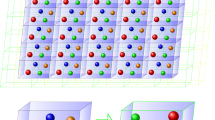Summary
The functional dependence of the specific heat of a crystal on the temperature may with advantage be expressed as a variation with temperature of the effective average frequency of the atomic oscillators, the same being determined from the argument of the Einstein function which gives the observed specific heat at that temperature. The usefulness of this representation is shown in the paper by a detailed discussion of the experimental data for diamond. It emerges that the distribution of frequencies adopted in the Debye theory is irreconcilable with the observed course of the frequency-temperature curve. It is also pointed out that the large excess which the specific heat calculated from that theory exhibits over the observed values in the region of low temperatures shows that the ideas on which that theory is based are misconceived and that the theory itself is untenable.
Similar content being viewed by others
Author information
Authors and Affiliations
Rights and permissions
About this article
Cite this article
Raman, C.V. The specific heats of crystals. Proc. Indian Acad. Sci. 44, 367–374 (1956). https://doi.org/10.1007/BF03046091
Received:
Issue Date:
DOI: https://doi.org/10.1007/BF03046091




